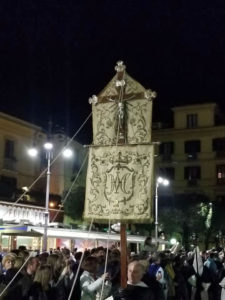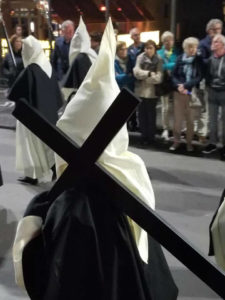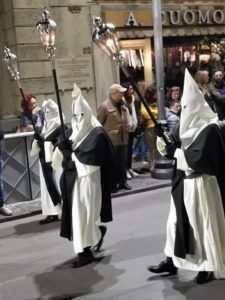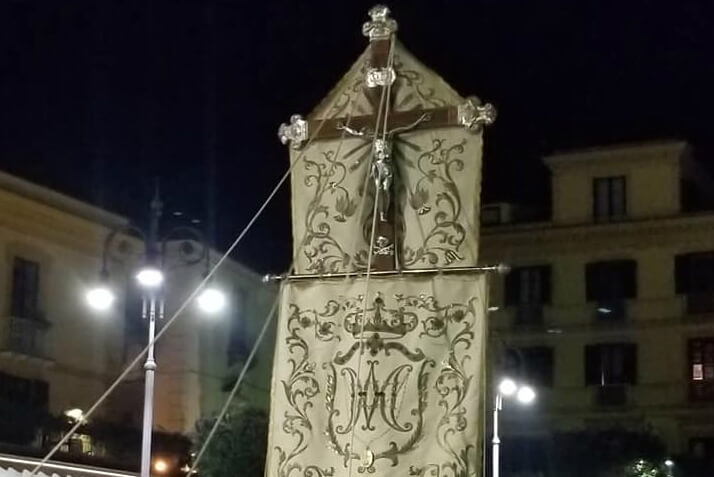Since being built in 1881, St. Leo the Great, my parish in Baltimore’s Little Italy, has proudly kept alive a handful of Italian immigrants’ traditions. My favorite Holy Week custom is its decades-old outdoor Stations of the Cross and procession through the neighborhood of Little Italy on Good Friday. The stations are set up at various homes and restaurants. A lone drummer leads the procession of a corpse statue of Jesus and solemn clergy, sisters, fellow parishioners, and visitors, as we stop to pray at each station. It is lovely and sad, simultaneously, and a beautiful tribute of the Passion of Christ.

Although we do not host the processions of what I am about to describe, all across Italy (Spain and Portugal, too), Catholic churches perform ancient ritualistic processions on Holy Thursday and Good Friday, where dozens upon dozens of hooded “penitents” (addolorati in Italian) don white- and black-hooded robes and carry lit torches, crucifixes displayed against decorated fabric, and icons of The Crucifixion on pillows. The Holy Thursday procession in Italian is coena dominus (last supper) and on Good Friday, it is via crucis (crucifixion of Jesus).
I had the good fortune of learning about – and experiencing – two processions while vacationing in Sorrento, Italy last week. On Holy Thursday evening in centro Sorrento, my five friends and I watched “The White Parade” in which Mother Mary is depicted searching for her son during a white-robed procession. A band commenced this “procession of hope” in which the Mother Mary is typically taken inside of various churches to see if her son is there. That procession is typically repeated at 3 in the morning.

On Good Friday we watched “The Black Parade,” a black-robed procession enacted from the church of San Agnello in the nearby mountainside town of Sant’Agnello, walkable from our hotel. Once we moved past the striking and disturbing similarity to the white robes of the racist Ku Klux Klan group, we were absolutely captivated. The significance of the pointed white hoods has nothing to do with the KKK and everything to do with Jesus’ death on the cross. While the Klan sides with the devil, the good-hearted devout Catholic penitents side with God.
The history goes that in the mid 12th century, Christian brotherhoods were formed (called converso), consisting of laymen who had made a life conversion of faith without entering monasteries: few material possessions, fasting and celibacy, while adhering to rules against gambling, womanizing, drunkenness, and profanity. Pope Gregory IX recognized these groups in 1227 as they carried out charitable activities. The pointed hoods and robes were worn to hide their sinfulness and identities – they chose to remain anonymous for their charitable works.
Some of the items carried on pillows included a crown of thorns, hammer, red robe, noose, Bible, wooden crosses, nails, rooster, lantern, and a fake hand. Other hooded men and boys carried wooden crosses, whips, swords, smoking incense, and many, many of the men carried torches flickering against the darkness. Interspersed between the processing penitents were variations of crucifixes carried on tall stakes – some against beautiful fabric.

Walking slowly and solemnly to the beating drum, we lost count as to how many penitents were processing – there were dozens upon dozens! A group of singing children processed as part of the Good Friday event, as well as a group of chanting men. We were mesmerized. The traditional ritual is passed generation to generation … from father to son.
The Black Parade is more somber, signifying a procession of death, which included a statue on a platform of a worried-looking Blessed Mother dressed in black, hands in prayer, eyes to heaven. Behind her was the horizontal corpse statue of Jesus, on a platform surrounded by flowers. The entire event was touching, surreal and beautiful.
Traveling introduces us to new customs in other cultures, learning as we go. It was completely rewarding to watch these hundreds of parishioners so devoted to their town parishes as they reenacted Jesus’ crucifixion.
Bravo



